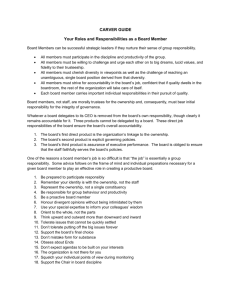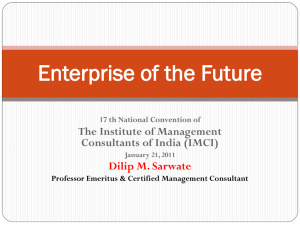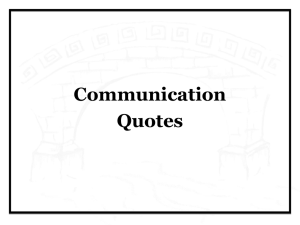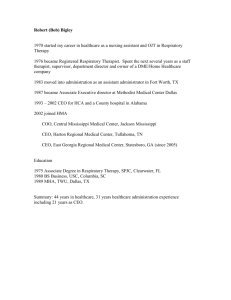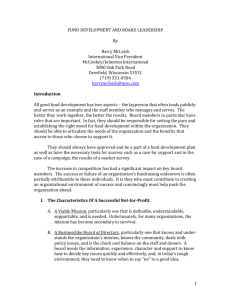The one question you should ask the CEO
advertisement
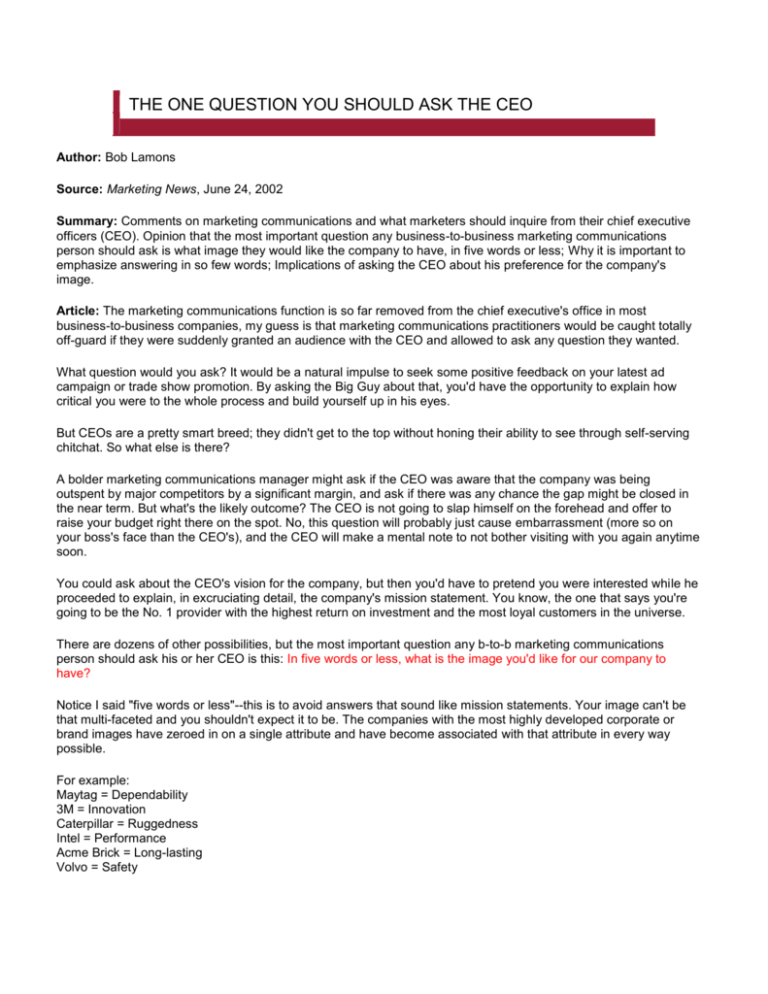
THE ONE QUESTION YOU SHOULD ASK THE CEO Author: Bob Lamons Source: Marketing News, June 24, 2002 Summary: Comments on marketing communications and what marketers should inquire from their chief executive officers (CEO). Opinion that the most important question any business-to-business marketing communications person should ask is what image they would like the company to have, in five words or less; Why it is important to emphasize answering in so few words; Implications of asking the CEO about his preference for the company's image. Article: The marketing communications function is so far removed from the chief executive's office in most business-to-business companies, my guess is that marketing communications practitioners would be caught totally off-guard if they were suddenly granted an audience with the CEO and allowed to ask any question they wanted. What question would you ask? It would be a natural impulse to seek some positive feedback on your latest ad campaign or trade show promotion. By asking the Big Guy about that, you'd have the opportunity to explain how critical you were to the whole process and build yourself up in his eyes. But CEOs are a pretty smart breed; they didn't get to the top without honing their ability to see through self-serving chitchat. So what else is there? A bolder marketing communications manager might ask if the CEO was aware that the company was being outspent by major competitors by a significant margin, and ask if there was any chance the gap might be closed in the near term. But what's the likely outcome? The CEO is not going to slap himself on the forehead and offer to raise your budget right there on the spot. No, this question will probably just cause embarrassment (more so on your boss's face than the CEO's), and the CEO will make a mental note to not bother visiting with you again anytime soon. You could ask about the CEO's vision for the company, but then you'd have to pretend you were interested while he proceeded to explain, in excruciating detail, the company's mission statement. You know, the one that says you're going to be the No. 1 provider with the highest return on investment and the most loyal customers in the universe. There are dozens of other possibilities, but the most important question any b-to-b marketing communications person should ask his or her CEO is this: In five words or less, what is the image you'd like for our company to have? Notice I said "five words or less"--this is to avoid answers that sound like mission statements. Your image can't be that multi-faceted and you shouldn't expect it to be. The companies with the most highly developed corporate or brand images have zeroed in on a single attribute and have become associated with that attribute in every way possible. For example: Maytag = Dependability 3M = Innovation Caterpillar = Ruggedness Intel = Performance Acme Brick = Long-lasting Volvo = Safety It's like trying to describe an acquaintance to someone who is not familiar with that person. You might say something like: "Bill is really smart, and funny, too." So Bill's image in this instance is reduced to smart and funny. Not bad, but I'm sure Bill's family would give him credit for a lot more than that. The reality is, however, that most of the people who know Bill would, by necessity, pare it down to the fewest possible number of words. It goes back to what Al Ries and Jack Trout said about "mental ladders" 30 years ago in their first book on positioning--the human mind can't deal with more than seven units (in any category) at a time. If you're No. 8, tough luck. In fact, in most b-to-b product categories, if you're No. 5 or 6 your days are probably numbered. If you've ever stumbled upon several people discussing your company at an industry reception, you were probably offended by the simplicity and (perhaps) total inaccuracy of their characterizations. But that's the way the game works: Their perception is your reality. Not that this is all bad, however. It can actually work to your advantage. If you've done a good job of claiming a certain image position, your competitors are going to have to deal with that--like 7 UP's "uncola" to Coke's "The Real Thing." Or Avis' "No. 2 and trying harder" to industry leader Hertz. If Wal-Mart is the low-price leader in consumers' minds, Kmart can run all the Blue Light specials it wants. The customers, unfortunately, will be in a different store. Business-to-business marketing managers who still think that customer buying decisions are based on features and benefits, and a logical, systematic evaluation of pro duct and service options, are really out-of-touch with today's market realities. There are simply too many choices and not enough time and resources to carefully assess them all. You've got to be in the top two or three to be seriously considered, and more often than not, that's an image problem, not a sales force challenge. Besides, by asking the CEO about his preference for the company's image, you're actually doing him a huge favor. After all, his primary legacy will be the way the company is viewed by its various publics (customers, suppliers, employees, investors and so on). No one will remember (or even be vaguely aware) of the many reorganizations he instituted. No one will give him much credit for the inevitable downsizings marketing communications professional and penny-pinching. And while it is important to grow the business, growing through wait for a surprise invitation. I would ask acquisition (the most popular method these that question in as many ways and by as days) can get you into trouble fast. It can also muddy an otherwise focused image. If your image is well-established and understood by all, maybe you can avoid some of those ill-advised acquisitions. In my mind, there's only one question a marketing communications professional should be asking the CEO, and I wouldn't wait for a surprise invitation. I would ask that question in as many ways and by as many means as possible. It's too important to let slide.

